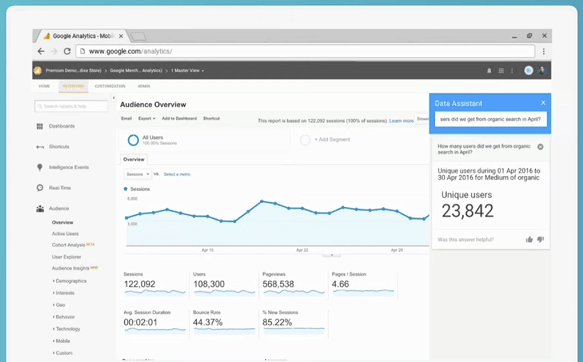La gran visión del Google Summit para el futuro!
Google, como siempre, sigue cambiando año tras año. Si hay alguna empresa que ha visto de cerca la derrota por estancación, son ellos. Ellos fueron la causa de la muerte (casi) de empresas como Yahoo y se han tomado la lección en serio.
Ayer por la tarde vi (por streaming esta vez, quizás algún día pueda repetir en persona) la presentación principal del Google Summit de Performance, el evento en el que Google anuncia las grandes novedades cada año.
Si estás interesado en las revelaciones sobre AdWords próximamente publicaremos un artículo sobre ello. Por ahora repasaremos la visión que Google tiene del futuro de Internet, la sociedad en general y su posición en ella.
El ajuste estratégico y visión del futuro de Google Summit
¡Sorpresa! El futuro es ‘mobile’ (móvil). Y no es sólo móvil, es ‘mobile first’ (móvil primero). Taladros corporativos aparte (esto ya llevan diciéndolo 2 años), la gran novedad está en cómo han planteado el móvil como puente entre el mundo off-line y el on-line, y como Google es la empresa en mejor posición para construir esos puentes.

Mobile First es la prioridad principal de las grandes empresas como Google.
El punto diferencial de las presentaciones de este año es que Google, casi por primera vez, ha decidido centrarse en la importancia del mundo offline, o sea, el mundo físico, el real de verdad. Normalmente lo ignoran como algo colateral y siempre barren hacia el territorio digital pero esta vez le han dado importancia al presentar al dispositivo móvil (y sus servicios y plataformas digitales) como el punto de interacción entre ambos mundos.
Ha sido muy refrescante oirles decir cosas como:
- La clave del éxito en los próximos años estará en construir los mejores puentes que conectan las personas y la información en el ámbito digital con las actividades y objetos del mundo físico.
- La presencia de Internet en la vida del ser humano ya empieza a madurar haciendo que se convierta en una herramienta para facilitar su vida, no como un medio con fin escapista o un mundo paralelo ‘mejor’. (No os preocupéis, las webs y los juegos online seguirán existiendo).
- Empezamos a poder medir cómo la toma de decisiones en el mundo offline se nutre de la información digital más a menudo que a la inversa.
Tal y como lo entiendo yo, la narrativa del Google Summit fue: cada vez más usamos internet para saber y decidir qué hacer, pero lo queremos hacer en persona, con gente, para tener una experiencia viva y fiable. Así, los mejores anunciantes aprenderán a utilizar el puente digital para conectar con sus audiencias tanto offline como online, buscando conexiones relevantes, estando dónde se les necesite para aportar valor. Google es la empresa que podrá hacerlo.
Obviamente, que durante el Google Summit quieran vender el sueño de que están destinados a ser la principal plataforma de interacción entre los usuarios y las marcas (basándose en la importancia de ser relevante y oportuno como anunciante) no es sorprendente. Pero que estén dispuestos a recuperar la ‘proto-idea’ de que el móvil y las plataformas online son canalizadores de la vida offline (y no la culminación de la experiencia humana en si mismos) y presente una visión de cómo aportarán a los cambios tecnológicos en el futuro, sí que es digno de análisis.
Personalmente, me parece una visión esperanzadora y espeluznante al mismo tiempo. A continuación la analizo a través de los activos digitales de Google.
Los pilares del imperio de Google en el nuevo paradigma del ‘mobile first’
Como hemos comentado antes, el liderazgo de Google en el ámbito del dispositivo móvil se ha puesto en entredicho y les ha costado muchos ataques que hasta dudan de su supremacía como empresa. Veámos qué visiones presentan del futuro.
-
Google Search:
Tienes una duda? Desconoces una referencia histórica? Quieres comprar algo? Te interesa un artista? Necesitas inspiración para una receta? Google tiene la respuesta para ti. El Alpha de Google es el servicio de búsquedas online. Es la industria que crearon de la nada y les puso en el mapa, y lo que ha alimentado la empresa con ingresos publicitarios.
Gracias al ‘search’ Google ha podido hacer todo lo demás, también es la razón original que hace de Google un servicio imprescindible. Somos pocos los que podemos recordar nuestro día a día sin este servicio al alcance de la mano, y por ello hemos inventado el verbo “googlear”.
Mientras nadie les adelante con una solución mejor para encontrar contenidos digitales, Google será un gigante digital con información detallada de las preocupaciones, necesidades y aspiraciones de una gran cantidad de personas.
-
Google Now:
El servicio de Google equivalente al Siri de Apple o la Cortana de Microsoft, se puede considerar como un asistente virtual. Sirve, sobretodo, para pedir cosas (hacer búsquedas), introducir eventos o recordatorios, solicitar información o datos.
En un futuro no muy lejano, Google quiere integrar esta herramienta en el interfaz de todas sus aplicaciones. Y no estoy hablando únicamente de buscar en YouTube o pedir información de tránsito en Maps, sino también para resaltar datos con lenguaje natural en plataformas como Analytics o AdWords. Quieren que lo podamos hacer todo sin teclear… ¡Impresionante!

Ejemplo del uso de Google Now en Analytics durante el Google Summit.
-
Google Maps:
La herramienta idónea para saber dónde estás y navegar por tus alrededores. Quizás no sea tan práctica a la hora de encontrar un peluquero o el bar más barato del barrio, pero tiene un sistema de navegación gratuito que funciona por todo el mundo y está completamente integrado a Calendar y demás aplicaciones.
Antes de Google el concepto de un mapa gratuito, interactivo, global, detallado y dinámico (hasta indica en qué dirección miras) era una fantasía futurista. Ahora, siendo conscientes de lo rápido que se ha convertido en realidad, no podemos ni imaginar como será cuando lo integren dinámicamente con todas sus aplicaciones, contenidos y anuncios. Será otro salto al futuro.
-
Gmail:
En la comunicación interhumana, Google tiene la potente baza de Gmail. Con una cuota de mercado del 15% (que no está mal para un mercado muy fragmentado), Google ofrece una buena herramienta para comunicarse de forma digital. Está integrado a otras aplicaciones como Calendar (aunque no es el único proveedor que lo hace) y ahora se está renovando con bandejas de entrada dinámicas que filtran los emails automáticamente.
Quizás en un futuro se convierta en un interfaz de notificaciones de todos los servicios, aparte de comunicaciones personales.
-
YouTube:
El 2o buscador más grande de Internet, YouTube es la plataforma más usada para ver, compartir y subir vídeos. Después de casi diez años como un espacio en el que sólo se veían vídeos graciosos y ‘amateur’ de mascotas y bebés, se está convirtiendo en un ecosistema de comunicaciones propio.
Con la llegada de los YouTubers, es solo una cuestión de tiempo que las plataformas de videos online (con YouTube como buque insignia) se consagren como un medio equiparable a la televisión, prensa escrita o radio. Ese día está al caer, y será Google que se llevará un pedazo importante del pastel.
-
Google Shopping:
El escaparate digital de productos creado y potenciado por Google puede parecer un poco fuera de lugar, pero representa su apuesta para contrarrestar el fuerte avance de Amazon en el nicho de ‘búsquedas de productos’,
Google no es el líder de este importante nicho, pero gracias al Shopping tiene la capacidad de presentar imágenes de productos, con precios y disponibilidad, en todas sus demás activos digitales.
Os imagináis ver el producto que necesitas en un mapa con precios alrededor de tu ubicación, incluidos cupones y descuentos? O un banner que enseñe productos según lo que ve que necesitas en tu correos? Da miedo, pero este es el futuro.
-
Calendar:
La aplicación de Google orientada a ayudarte a gestionar tu tiempo. No es una herramienta excepcional porque hay muchas en Internet, pero su integración transversal con todos las demás herramientas de Google (crear eventos desde el email, añadir personas de tus contactos, ponerle una ubicación) la hace muy poderosa.
Ahora, imaginémonos que le podemos hablar para que nos ayude a agendar las visitas a tus clientes en el mejor orden según la ubicación de las oficinas, o a poner recordatorios automáticos según nuestras comunicaciones en chat y email, o a recordarnos visitas al doctor o la renovación del dni. Preferimos una vida más fácil con una secretaria digital o proteger las peculiaridades de nuestro día a día? El futuro nos dirá.
-
Hangouts:
Combinación de software de chat y videoconferencia, quizás no se use tanto en comparación a otras herramientas pero al estar integrado en todas las aplicaciones de Google (desde Gmail a Calendar hasta trabajando en colaboración en Docs) le da una dimensión práctica adicional.
Pronto, podremos hablar con el buscador o agendar eventos de calendar con Google Now desde el chat en el momento en el que nos surja la necesidad.
-
Android:
Presente en casi el 62% de todos los dispositivos móviles, si nos remontamos a los tiempos en los que Nokia aún creía que conseguiría hacer el salto al smartphone, vemos que Google se ha convertido en el caballo ganador inesperado. El potencial de este servicio “gratuito” (ingresos a través de apps, datos sobre uso de dispositivos móviles, identificación del usuario móvil, etc) es demasiado grande para explorar aquí, pero, indudablemente, convierte a Google en una de las fuerzas más potentes en el desarrollo del futuro móvil.
Si le sumamos toda la integración de aplicaciones que hemos estado visualizando en este artículo, es difícil anticipar hasta donde serán capaces de llevarnos.
-
Chrome:
Irrumpió en el mercado de forma inesperada y en pocos años se convirtió en el navegador por excelencia en la mayoría de países. Parece que no tenga mucha importancia en el conjunto de aplicaciones de Google, pero gracias a las ventajas de crear un usuario para compartir contraseñas y marcadores a través de dispositivos, es una de los puentes con los que Google es capaz de identificarte en múltiples dispositivos.
En resumen, una herramienta más a su disposición para moldear el futuro.
-
Drive:
El archivador o trastero (según tu inclinación) digital de Google, te ofrece la posibilidad de almacenar múltiples gigas de documentos, fotos, videos y más. Integrado de forma cada vez más dinámica con las demás herramientas, está adquiriendo importancia. Por ejemplo, si quieres enviar un archivo de +25 mb en Gmail ya no necesitas enviar un enlace de WeTransfer o utilizar Dropbox, Google automáticamente te lo guarda en Drive y genera un enlace para que lo pongas en el email.
¿Como evolucionará cuando más dimensiones de nuestras vidas, online y offline, se almacenen en la nube? ¿Se convertirá en nuestro dni del futuro, en nuestra cartera, en nuestro mochila? Quien sabe.
-
Suite ofimática Google Apps:
Una versión simplificada pero potente del Office de Microsoft, incluye herramientas para editar textos, tablas de cálculo, presentaciones y formularios, todo en la nube y de forma colaborativa.
No significa un gran avance en cuanto a sofiticación y mejora de las herramientas pero sí que simboliza un gran cambio: desde su creación (sin olvidar el proyecto open source de LibreOffice y similares) cualquier persona con un ordenador tiene la capacidad de trabajar legalmente y a un nivel profesional suficiente sin pagar un solo centavo.
Y con un diferenciador importante: el trabajo colaborativo. En Google Apps pueden escribir varias personas en el mismo archivo, y próximamente esta capacidad pasará a las demás aplicaciones y podremos escribir emails simultáneamente, generar informes ‘a cuatro manos’ y editar videos en YouTube al mismo tiempo. Un potencial impresionante.
Google, el mejor posicionado para ‘comerse’ el futuro
Sinceramente, leyendo esta larga lista de activos digitales, su distribución a través de las distintas necesidades, comportamientos offline y online del usuario común, y sus posibilidades de evolución, me quedan pocas dudas de que Google está fantásticamente posicionado para ser una pieza clave en la creación del futuro de la humanidad. Espero haber ayudado a hacer esa visión más cercana, si no palpable.
Ahora bien, que estemos en buenas manos o sepamos a dónde vamos, eso ya es otra cuestión.



